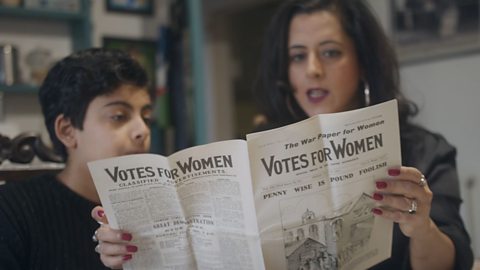Iman:
My name is Iman, I'm 14 years old, and I'm a Muslim. I'm learning about WorldWar Two at school. And I've come to meet an author, ShrabaniBasu, who has written a book about an incredible woman, who was a secret agent in World War Two.
She was Britain's first Muslim war heroine. World War Two started in 1939 when Poland was invaded by Nazi Germany, led by Adolf Hitler. France and Britain declared war on Germany because they didn't think what Hitler was doing was right. The war lasted until 1945.
Can you tell me how you first found out about Noor Inayat Khan?
Shrabani Basu:
There was an article about the contribution of Indian soldiers to the Second World War,and it had all of these photos of all these men in turbans and uniforms,and in a corner of this newspaper was a tiny photograph of a woman in a uniform. And being a woman, I was just drawn to that particular photograph. I wanted to know how a young Indian Muslim woman was in the heart of the war in Europe. And that set me on Noor's trail.
Iman:
What was Noor's childhood like?
Shrabani Basu:
She was born in Moscow. Her father was Indian, and she came from a very distinguished Muslim family. Her mother was American. So she was born in Moscow, and then the family moved to London for a while, and then they moved to Paris. So she grew up in Paris, but in 1940, with the German army just outside Paris, Noor and her brother have to make a decision. They were Sufis, which is a branch of Islam which believes in non-violence,in music and in meditation. But they decide that they can't stand by and watch. They have to do their bit.
So they decide they're going to go to England and they're going to join upwith the war effort.
Iman:
What did Noor do next?
Shrabani Basu:
She joins the Women's Auxiliary Air Force. She's now in a uniform and she's training to be a radio operator. And this was a job that only men had done before, so it's really important that she's doing this. She's learning to code, she's learning the morse code and she's very good. But whilst she's tapping away at her morse code, she is being watched by a secret organization called the Special Operations Executive. They are looking out for people with language skills.
Now, remember, Noor spoke fluent French. She knew the area well, so she's perfect for them for the Secret Service.
Iman:
What did Noor do as a spy?
Shrabani Basu:
She has a false passport. She has to learn a different story undercover. She has a new code name, she's now called Madeline, she practices her signature. And then on the night of June 16th, 1943, she is flown to Paris and she joins the rest of her team. But of course, things are not going to go as smoothly as we thought.
Iman:
What happened next?
Shrabani Basu:
Well, disaster strikes her circuit. All the top operatives, they're all arrested. Somebody has betrayed them. And so Noor goes underground. London asks her to come back. They say, "we'll organise a flight, it's very dangerous, come back." But Noor says no.She says she's the last link left between Paris and London and she's going to carry on. So Noor does this for 4 months, it's really dangerous, but she keeps the Germans guessing, they can't catch her. She changes her hairstyle. She moves from place to place, and she just keeps beating them. She's one step ahead, but her luck ran out. She was betrayed.
Iman:
Did they catch her?
Shrabani Basu:
They did. So they took her to prison in their headquarters in Paris. But Noor fought back. She tried to make escape attempts, but they did take her to prison in Germany. And then after that, she was taken to Dachau concentration camp. This concentration camp is where people were taken by the Nazis for their race, for their religious beliefsfor their political views, or their sexuality. Noor was taken there, she was torturedand she was executed in September 1944. But, she went down screaming "liberté!", which means liberty or freedom. They didn't break her spirit, and I think that's what we take away from this.
After the war, for her extraordinary bravery, she was awarded the George Cross by the British which is the highest civilian honour. It's given to ordinary peoplewho do brave things. And France also gave her their highest civilian honour, which is the Croix de Guerre.
Iman:
She sounds like such an inspiring and amazing person, why isn't she better known?
Shrabani Basu:
I didn't know about her, which is why I went on this journey. And when I met her family,I met her brothers, and I promised them I would do everything to make her a household name. I applied for a blue plaque for Noor, and then I said we should have a memorial for Noor. A lot of my readers were writing to me saying, "Why isn't there a memorial for her?" So we campaigned for a memorial, and in 2012, we had success. We got the permission, we got the memorial, and Princess Anne unveiled this beautiful memorial in Garden Square. And it's the only statue of an Asian woman in Britain in a public space.
It makes me really happy and satisfied that, you know, I could bring Noor's story out to people.
Iman:
It was fascinating to speak to Shrabani about Noor Inayat Khan. As a Muslim girl myself, I found her life so inspiring. I hope that her story will be taught at schools around the country, so more young people will find out how special and courageous she was.
Video summary
Author Shrabani Basu talks to 14 year-old Iman about the life of Noor Inayat Khan, a secret agent and Britain's first muslim war heroine.
Noor was born in Moscow and grew up in Paris, before travelling to England to join the Women's Auxiliary Air Force in 1940.
Whilst working as a radio operator she was recruited by the Special Operations Executive (SEO) and, thanks to her fluent french language skills, began working undercover for the Secret Service in Paris.
Noor bravely carried on working in Paris, even after a number of top operatives were betrayed and arrested, as the last intelligence link between Paris and London. She evaded capture for some time but eventually was betrayed and ended up in Dachau concentration camp, where she was executed.
Shrabani was part of a campaign to get Noor's achievement recognised and, in 2012, Princess Anne unveiled a memorial, which is the only statue of an Asian woman in Britain in a public space.
This short film is from the BBC Teach series British Asian History.
Teacher Notes
Learning points:
- To learn about the reasons why people have emigrated to Britain from Asia over time, and in the post-war years.
- To learn about the the contribution of a diverse range of people during World War Two: focus on women.
Key Vocabulary
This film gives you the chance to explore and learn this vocabulary in the context of a personal story.
Vocabulary used in the film:
- Secret agent
- Honour
- Occupy (Paris)
- Supplies
- Commemorate
- Heroine
- Disputes
- Vital
- Concentration camp
- Memorial
- Auxiliary Airforce
Vocabulary useful for discussing the film:
- Immigration and immigrants - coming to live permanently in another country.
- Emigration - leaving one's own country in order to settle permanently in another.
- Asia/Asian - the largest and most populous continent on earth.
- Britain/ British - "Great Britain" is often used to refer to England, Scotland and Wales, including their component adjoining islands.Great Britain and Northern Ireland now constitute the United Kingdom.
- Community - a group of people living in the same place or having a particular characteristic in common.
- Culture - a pattern of behaviour shared by a society, or group of people.
- Discrimination - the unjust or prejudicial treatment of different categories of people.
- Diversity - differences in racial and ethnic, socioeconomic, geographic and academic backgrounds.
- Equality - when people are treated the same, regardless of what they look like or where they come from.
- Inclusion - being a part of what everyone else is, being welcomed and embraced as a member who belongs.
- Legacy - something we inherit from past generations and pass to our future generations.
- Prejudice - a preconceived opinion that is not based on reason or actual experience.
- Racism - the belief that people of different races or ethnic groups have different value in society, and using this against them.
Before watching the film
You may want to discuss what your pupils understand by the word ‘immigrant’ and what they already know about people who have come to live in the UK, over time. Pupils could discuss what they understand by the term ‘community’ and whether they identify as being part of any communities.
You could find out what your pupils already know about men and women during World War Two, and whether they know anything about what women did at this time.
Please note, the subject of the film, Noor, died in a concentration camp. The reasons why people were taken to concentration camps are explained, and Shrabani Basu says that she was ‘tortured’ and then she died. Please consider the suitability of this for the pupils in your class. This section is from 03:39 until 04:04.
Questions to consider
Depending on the focus of your lesson, you may wish to pause the short film at certain points to check for understanding, asking questions such as:
- In which ways do you think Noor was unusual compared with many women in Britain at the same time?
- How do you think Noor’s life changed when she moved to England?
- How do you think Noor might have felt when she was trained as a spy?
- Why do you think Noor was awarded the George Cross?
- Why do you think Noor is not more well known?
- How do you feel about the fact that Noor’s statue is the only statue of an Asian woman in Britain?
Activities to further explore learning
- Pupils could use a range of sources about the roles which women took on during World War Two to write a non-fiction account.
- Pupils could use this film as well as other sources, to write a biography of Noor - perhaps referencing Shrabani’s own biography of Noor: Spy Princess, 2006.
- Pupils could create sculptures of Noor, like her memorial statue, as part of art lessons.
How this film meets the aims of the National Curriculum in England:
- History
This film will help you to ensure your pupils understand the history of these places as a coherent, chronological narrative, focusing on the 19th Century to the present day. Through this personal story, pupils will learn about the diversity of people who have shaped this nation and how Britain has influenced and been influenced by the wider world.
Pupils will develop deeper understanding of historical concepts such as continuity and change, cause and consequence, similarity, difference and significance, and use them to make connections, draw contrasts, analyse trends, and frame historically-valid questions.
They will also gain historical perspective by placing their growing knowledge into different contexts, understanding the connections between local, regional, national and international history; between cultural, economic, military, political, religious and social history; and between short- and long-term timescales.
How this film meets the aims of the Scottish Curriculum:
Social Studies
This film will enable pupils to compare and contrast communities and the lives of people in the past with their own, and to contribute to a discussion of the similarities and differences.They will find out why people and events from a particular time in the past were important, placing them within a historical sequence.
Health and Welbeing Across the Curriculum
This film will help pupils to develop self-awareness, self-worth and respect for others, understanding diversity and that it is everyone’s responsibility to challenge discrimination.
How this film meets the aims of the The Northern Ireland Curriculum:
- The World Around Us
This film will enable pupils to learn about how people and places have changed over time, the causes and effects of people moving from one place to another, and the positive and negative impacts of people on places. Exploring the lives and memories of people from the past is part of the history non-statutory guidance and this film provides an ideal starting point for this.
- Personal Development
This film will enable pupils to appreciate the similarities and differences between themselves and others by providing a starting point for discussing cultural heritage, community and the diversity of people living in Britain.
How this film meets the aims of the National Curriculum in Wales:
History
This film will enable pupils to place events chronologically, identify similarities and differences between ways of life in different places during the 20th Century, and to discuss the consequences to people of historic events.Personal and Social Education Framework
This film will help pupils to see people who have been active citizen and help them to develop respect for others. Through personal stories, pupils will learn the value of diversity and recognise the importance of equality of opportunity.
Zi Lan Liao - Chinese migration to Britain. video
Music teacher, Zi Lan, talks to 10 year-old Cherie about how she came to Liverpool as a child and why people emigrated to Britain from Asia.
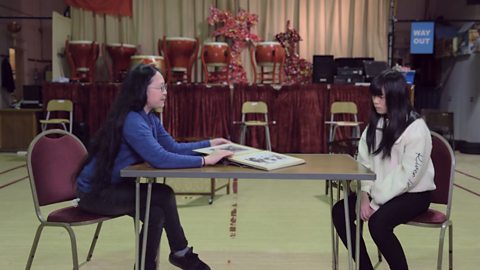
Ganesh Rai - The Gurkhas contribution to the British army. video
Eight-year-old Reva talks to Captain Ganesh Rai about the contribution of Gurkha soldiers to the British army over the past 200 years, especially during World war Two.
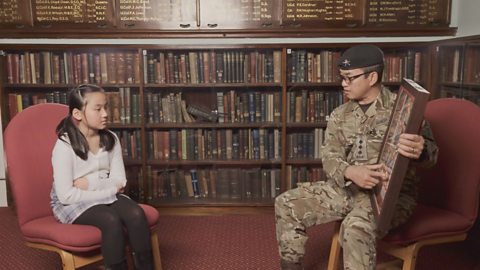
Anna Nguyen - Vietnamese migration after the Vietnam War. video
Artist Anna Nguyen talks to 11 year-old Vincent about the Vietnamese migration to Britain after the war between North and South Vietnam.
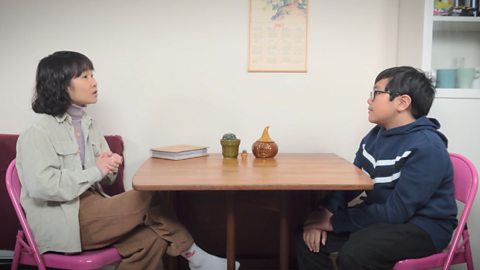
Marigin Opiala - Migrating from the Philippines to work for the NHS. video
In this short film for primary schools Marigin Opiala talks to 15-year-old Bea about why she moved to the UK, along with thousands of other Filipino nurses, to work for the NHS.
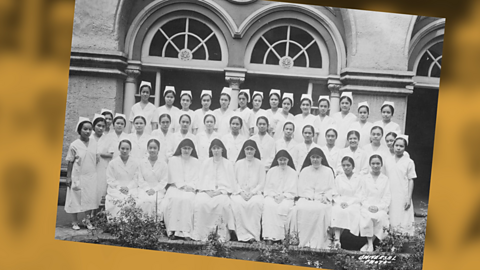
Moey Hassan - Pakistani migration to the UK. video
Actor and musician Moey Hassan talks to his nephew, 10 year-old Yusef, about the Pakistani migration to the UK.
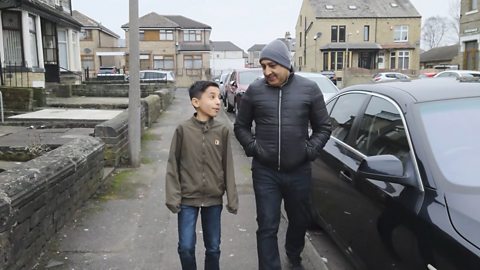
Rupal Rajani - The forced migration of Indian people from Uganda. video
Radio DJ Rupal Rajani talks to 10-year-old Ayush about how Indian people living in Uganda in the 1970's were forced to leave by the Ugandan President Idi Amin.
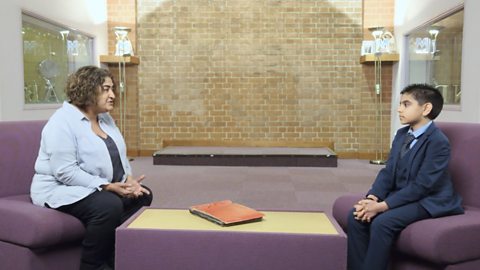
Hermann Rodrigues - South Asian migration to Scotland. video
Photographer Hermann Rodrigues talks to 15 year-old Rohit about the South Asian communities that migrated to Scotland.
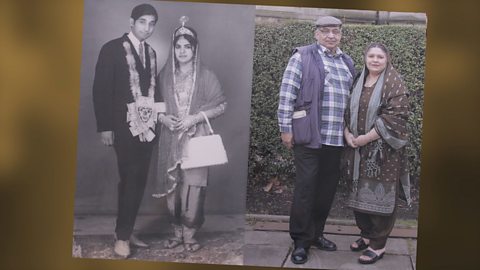
Sophia Duleep Singh - The Indian Princess who helped women gain the right to vote. video
11 year-old Hari talks to his mum about an Indian princess called Sophia Duleep Singh, who helped women in the UK gain the right to vote.
